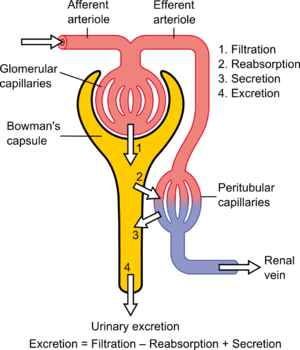Ultrafiltration (kidney)
This article needs additional citations for verification. (June 2011) |

In renal physiology, ultrafiltration occurs at the barrier between the blood and the filtrate in the glomerular capsule (Bowman's capsule) in the kidneys. As in nonbiological examples of ultrafiltration, pressure (in this case blood pressure) and concentration gradients lead to a separation through a semipermeable membrane (provided by the podocytes). The Bowman's capsule contains a dense capillary network called the glomerulus. Blood flows into these capillaries through the afferent arterioles and leaves through the efferent arterioles.
The high
Glomerular pressure is about 75
In hemodialysis centers, ultrafiltration takes place in a hemofilter on the hemodialysis machines, when the blood pressure is greater than the dialysate pressure (difference = transmembrane pressure (TMP)). This removes fluid from the blood while keeping its blood cells intact.
Selectivity
The structures of the layers of the glomerulus determine their permeability-selectivity (permselectivity). For instance, small ions such as sodium and potassium pass freely, while larger plasma proteins, such as hemoglobin tetramers, haptoglobin bound hemoglobin and albumin have practically no permeability at all. Also, negatively charged molecules will pass through far less frequently than positively charged ones.
Slow continuous ultrafiltration
Slow continuous ultrafiltration (SCUF) is an artificial method which approximately mimics the ultrafiltration function of the kidneys. SCUF is a continuous
See also
- Ultrafiltration (industrial)
- Ultrafiltration
- Aquapheresis
References
- ISBN 978-0-387-96304-4.
- PMID 11805387.
